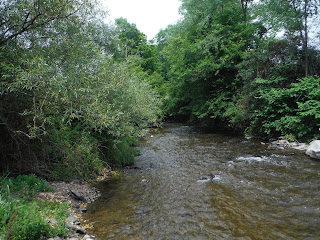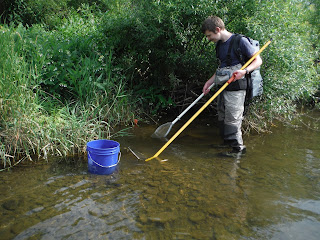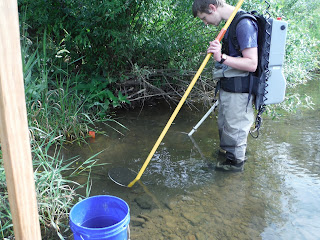I had a chance to sample this weekend and took it, the rain has made getting out difficult. First are pictures from the Hudson River.
Below the bridge working.
A turtle that walked by while I was working. I placed him in the bucket to make sure I could get a picture of him. He lost his right hand at some point so all he had was a stump. This is, I think, a painted turtle (Chrysemys picta). This was certainly the trip of "herps" I found many at all of my sites.
He got temporally stuck on this rock. It was interesting to listen to the bouncing of the shell against the stones.
Fully submerged, at this point it was unsure if I was a threat or not. It decided that I was a threat and moved off.
Down the river this is march where the stream I work on meets the river. This is only a minute drive from where I work but the stream is very different from under the bridge.
Looking through the bridge is the marina and where the stream meets the Hudson River.
The shore of the Hudson River. This river has true tides and large portions of the river are fully saline or partially so.
A sailboat traveling downriver just before I left the Hudson Valley again.
And so I left and went to the Delaware River.
Here is a tiny froglet I found in one of my sampling pools. It was accidentally captured when I was collecting ammocoetes, so I took a picture of him before releasing him.
And like I said, the herps just keep coming. Here is a green frog (?) (Rana clamitans melanota). He hopped away from me so I quickly grabbed him and placed him on the ground for a picture.
Same frog, from the top down.
Here is an injured ammocoete, but not from me. It is uncommon but does happen that I find and catch injured ammocoetes. This is the most injured I have seen an animal. This animal lost probably >10% of its body length to something. Most likely something bit the tail off when the animal was captured and it got away.
Everything is looking green, and the water is staying high. A wet June and beginning of July has meant high water levels have persisted since the beginning of June.
More injured ammocoetes, this time I had marked it although the injuries are again unrelated to me.
These three pictures are all of the same animal. If you look closely you will see divots in the body and white scar tissue. I have no idea what this is from, though it may have been mouthed by a predator and escaped.
Another dead thing. Here are just the wins and part of the thorax of a male dusky winged damselfly. Probably a bird caught it while it was darting about and ate him up. Life is hard for the pretty active little fliers.
The stream was clearely rearranged during the last storm. Rocks and sand were moved and this cobble bar changed shape. Only some of the rocks are dry right now, but by August more of this may be exposed.
Finally, an underwater shot of the rocks. The brown color is actually from all of the algae (Diatoms) that cover the rock. The water is quite clear though so little algae is in the actual water. Many species depend on this algae for food.
Well that is all for now, new posts when I go back out or find another interesting lamprey related news bit.





































